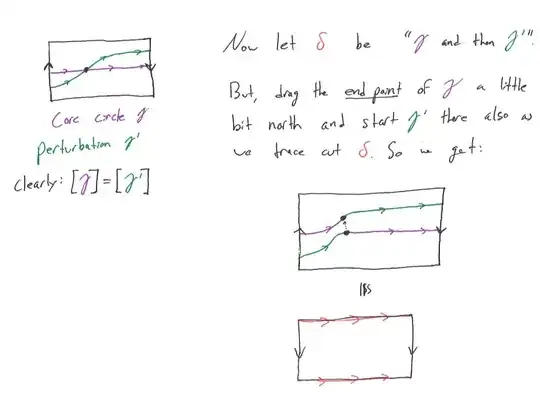One can use covering space theory to understand this, similar in a way to how covering space theory is used to prove that the fundamental group of the circle is infinite cyclic (which is sometimes the first nontrivial example of a fundamental group calculation that a student sees in a topology class; see for example the textbook of Munkres).
In some visualization using this covering space method works even better for $\pi_1(\mathbb RP^2)$ than the fundamental group of the circle, because the fundamental group is so much smaller: it has only two elements.
Here's some details.
The universal covering map $S^2 \mapsto \mathbb RP^2$ allows one to express $\mathbb RP^2$ as the quotient space of the ordinary unit sphere $S^2$ under the action of $\mathbb Z / 2 \mathbb Z$ by deck transformations: the non-identity element of the deck group is the "antipodal reflection" map $R(x)=-x$.
What this means is that objects in $\mathbb RP^2$ can be visualized as objects in $S^2$ that come in "antipodal reflection" pairs.
For example, a point in $\mathbb RP^2$ can be visualized as a pair of antipodal points in $S^2$. For the base point $x \in \mathbb RP^2$, let's use the north-south antipodal pair: $X = \{P_N,P_S\}$, where the north pole is the point $P_N = (0,0,1)$, and the antipodal reflection of $P_N$ is the south pole $P_S=(0,0,-1)$.
A path $\gamma$ in $\mathbb RP^2$ with initial point $X$ can be visualized as an antipodal reflection pair of paths in $S^2$. One of that pair is a path I'll denote $\gamma_N$, which has initial point $P_N$. The antipodal reflection of $\gamma_S$ is a path $\gamma_S$ which has initial point $P_S$: as your right index finger traces along $\gamma_N$ starting at $P_N$, simultaneously your left index finger traces along $\gamma_S$ starting at $P_S$, and at all times the tipes of your two index fingers are located at an antipodal pair of points.
Here is an example of a closed path $\gamma$ in $\mathbb RP^2$ based at $X$ that represents the identity element of $\pi_1(\mathbb RP^2,X)$: let $\gamma_N$ be a small circle which starts and returns to $P_N$, staying near $P_N$ at all times; and let $\gamma_S$ be the antipodal reflection circle, which starts and returns to $P_S$, staying near $P_S$ at all times. The reason that this path represents the identity element of $\pi_1(\mathbb RP^2,x)$ is that $\gamma_N$ can be homotoped (rel $P_N$) to the constant path at $P_N$, and, simultaneously, the antipodal reflection of that homotopy is a homotopy of $\gamma_S$ to (rel $P_S$) to the constant path at $P_S$.
Now let's consider the key question: What is the general picture of a closed path $\gamma$ in $\mathbb RP^2$ based at $X = \{P_N,P_S\}$? Since $\gamma$ starts at $X$, we visualize $\gamma$ as an antipodal pair of paths, $\gamma_N$ starting at $P_N$ and $\gamma_S$ starting at $P_S$. But also $\gamma$ ends at $X = \{P_N,P_S\}$, and so $\gamma_N$, $\gamma_S$ must end at $P_N,P_S$, but not necessarily in that order. There are two possibilities:
Type 0: $\gamma_N$ ends at $P_N$ and $\gamma_S$ ends at $P_S$; OR
Type 1: $\gamma_N$ ends at $P_S$ and $\gamma_S$ ends at $P_N$.
If $\gamma$ is of Type 0 then $\gamma$ is homotopy to the identity rel $X$. This is not hard to see, because $\gamma_N$ is a closed path based at $P_N$ and $S^2$ is simply connected so $\gamma_N$ is homotopic rel $P_N$ to the constant path at $P_N$; and taking the antipodal reflection of that homotopy, we obtain a homotopy rel $P_S$ of the path $\gamma_S$ to the constant path at $P_S$.
But if $\gamma$ is of Type 1 then it is not homotopic to the identity rel $X$: the path $\gamma_N$ starts at $P_N$ and ends at $P_S$, and under a path homotopy its endpoints never move, so the result of a homotopy on $\gamma_N$ rel endpoints is another path that starts at $P_N$ and ends at $P_S$; and similarly for $\gamma_S$, by antipodal reflection.
Here's two things that you can think about, to complete the picture.
First, any two paths $\gamma$ of type $1$ are homotopic to each other (hint: any two paths in $S^2$ with the same initial point and the same terminal point are homotopic to each other rel endpoints).
Second, given two paths $\gamma,\delta$ in $\mathbb RP^2$ of type 1, the composition $\gamma * \delta$ has the following properties:
- $(\gamma * \delta)_N = \gamma_N * \delta_S$, which is a closed path based at $P_N$.
- $(\gamma * \delta)_S = \gamma_S * \delta_N$, which is a closed path based at $P_S$.
To put this another way, the concatenation of a pair of type 1 paths is a type 0 path: if you go from the north pole to the south point, and if you then go from the south pole to the north pole, your entire trajectory takes you from the north pole back to the north pole (artic terns do this every year, I have heard).
From this, one sees that the group operation in $\mathbb RP^2$ is isomorphic to the group operation in $\mathbb Z / 2 \mathbb Z$, where type 0 paths represent the identity element of $\mathbb Z / 2 \mathbb Z$, and type 1 paths represent the non-identity element, and the composition of a pair of type 1 paths is a type 0 path.
